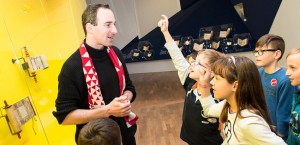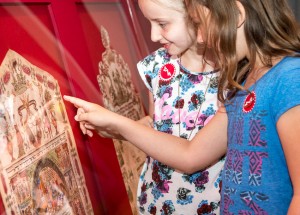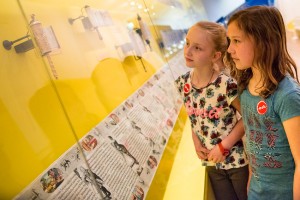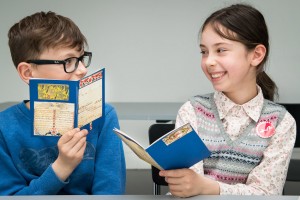
Schoolchildren on a guided tour of the exhibition “The Creation of the World”
© Jewish Museum Berlin, photo: Nadja Rentzsch
“I know!” shouts Tamo* (aged 10): “It’s Jewish writing!” “It’s called Hebrew—Hebrew writing” Mia (aged 10) corrects him. She knows the term because her best friend comes from Israel. She has seen letters like this before, at her friend’s house. Alexander (aged 34) chuckles. He works at the Jewish Museum and is giving a group of primary schoolchildren from Berlin a tour of “The Creation of the World,” our current temporary exhibition. On display are historical manuscripts and artful illustrations.

Workshop participants study a richly decorated marriage contract
© Jewish Museum Berlin, photo: Nadja Rentzsch
Leonie (aged 9) marvels “How old they are!” She has never seen books like this before. Curiosity has the children poring over the display cabinets. When they reach the ketubot, Jewish marriage contracts, Alexander explains the purpose of the richly decorated documents. “My parents have a contract too,” reports Katharina (aged 10). “So that they won’t argue and will always love each other.” “That’s silly,” says Chiara (aged 9) incredulously, shaking her head. “Love by contract?” Kolja (aged 10) also thinks it’s funny: “Like when buying a car?” “People should do as they like! Marriage contracts are common, even today. And they can be useful in times of crisis,” says Alexander, putting an end to the discussion before continuing the tour. There is much more to see: magnificent megillot, for example. Here too, Mia knows enough to chalk up a point: “The Esther scroll is used on Purim.” She once took part in the festivities with her friend, Mia proudly announces. Esther is the Jewish woman who saved her people from the wicked Haman. Whenever Haman’s name is mentioned, everyone makes a trememdous din with a ratchet. It is great fun.

Esther scrolls in the exhibition “The Creation of the World”
© Jewish Museum Berlin, photo: Nadja Rentzsch
At the end of the tour, Alexander leads the children to the Academy of the Jewish Museum, to the creativity workshop. There, a bookbinder and a calligrapher await the boisterous group. Rapidly, smocks are donned, and small hands grasp paper, ink, and quills. The calligrapher explains what to do. She has even brought quills made from bamboo. They grow in a friend’s garden. The children listen, open-mouthed. Then they set about making their manuscripts.

In the end, everyone has his or her own hand-bound and decorated booklet
© Jewish Museum Berlin, photo: Nadja Rentzsch
In the bookbinding workshop in the next room the children are looking skeptically at needles and thread. They’ll never manage that—such a tiny hole! And they’re supposed to sew together sheets of paper? Yet with patience and some support they manage after all. Later they look with pride at their hand-made booklets. Then copies of Jewish script are handed out, so they can decorate the booklets. “Me too!” insists Tamo. “I need a picture with Jewish writing!” Mia rolls her eyes: “Hebrew writing!”
Nadja Rentzsch, Education
(*Participants’ names have been changed)
PS: If you would like to enroll your class (years 3 to 13) in the program “Beautiful Pages – The Culture of Writing,” available until 3 August 2014, please contact us by phone: +49 30 25993 437 or by e-mail: kinder@jmberlin.de